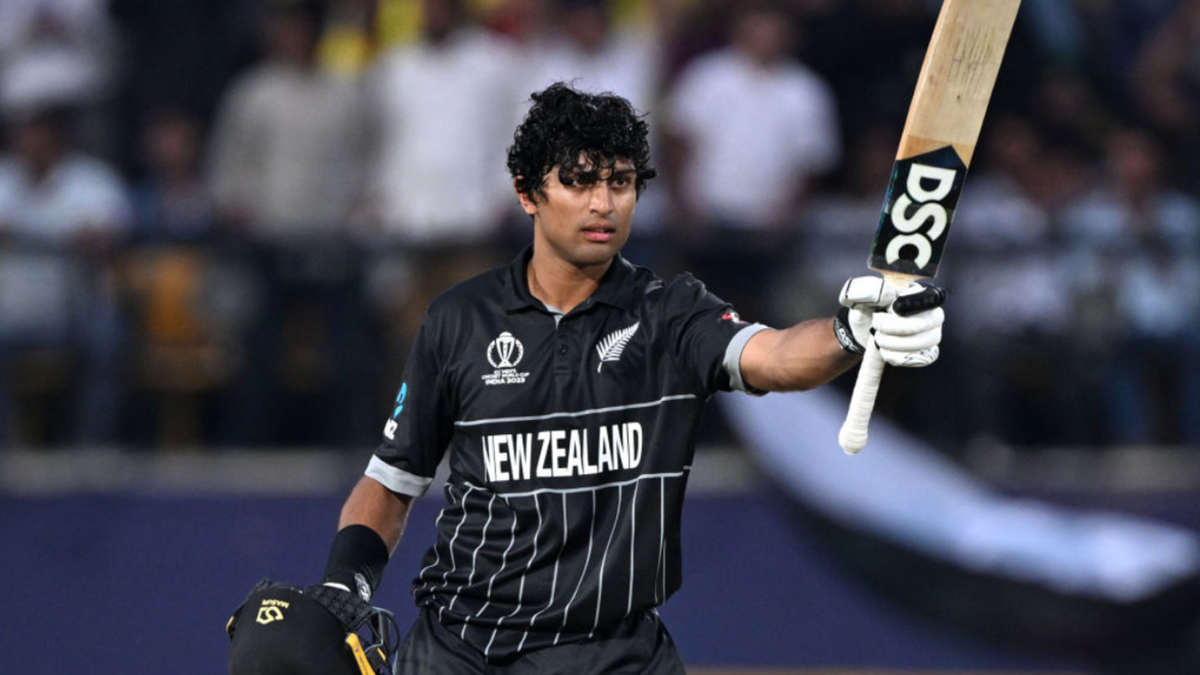
From being a backup to being New Zealand’s most important batter at the World Cup, Rachin Ravindra‘s rise has been astronomical. As Aadya Sharma writes, there’s no one quite like him among the current generation of cricketers around the world.
To bet on the World Cup with our Match Centre Partners bet365 head here.
You’re probably tired of the Rachin-Sachin wordplay already. By the looks of it, it’s not just the portmanteau – the 23-year-old seems to have borrowed some of the same precocious batting talent too.
When New Zealand played Australia – the Black Caps falling five short of a record World Cup chase – the cameras panned into their dressing room. As Ravindra appeared, Ian Bishop, forever the man for indelible one-liners, thundered: “Rachin Ravindra is a superstar under construction, on the world stage”, breaking away from the flow of a thrilling finish to celebrate one man’s marvel act.
Who would have thought this three weeks ago, when Ravindra was an unlikely starter for New Zealand .
A promotion to No.3, born out of Kane Williamson’s absence, turned from stop-gap to stop-that in the matter of one game. Until then, Ravindra had not batted above six in ODIs, his eight innings fetching a solitary fifty, his role reserved to late cameos. There was spark, no doubt, evident from a brave, in-vain resistance against England at Lord’s a fortnight before the World Cup. That 61 off 49 was also in beautiful contrast to the 91-ball 18* against India in the 2021 Kanpur Test, the first time the larger world took note of his batting talent.
Nearly two years since, Ravindra has become established as a breakout star at a global event, powered by two imperious centuries against England and Australia. One came in a clinical blanking of the defending champions, the other nearly pulled off the improbable. Both those knocks, and two other fifties have statistically and stature-wise, managed to haul him into some pretty special categories.
Only two under-24 batters – Ravindra and Tendulkar – have hit two men’s ODI World Cup centuries. Keep that age filter on, and they’re the only two to score 400 or more runs in a single World Cup edition. No New Zealand batter has scored more centuries in their ODI World Cup careers. Among all top-order World Cup batters (No.1 to 3) with at least 400 runs, Ravindra’s average (81.20) is only behind Shakib Al Hasan and Sir Viv Richards. The strike rate (107.69) is the best after Brendon McCullum and Jason Roy.
[breakout id=”0″][/breakout]
Numbers suggest a lot, but the optics are even better. Ravindra is lightning quick on his feet, immaculately shifting between his front and back foot, unafraid to go deep in his crease against the spinner and brave enough to hook the quicks off his helmet. Often though, impressive young ones aren’t able to translate a flurry of strokes into something substantial, but here is a young Ravindra, barely a year into his ODI career, spearheading two record World Cup run-pursuits as if he’s been doing so for a decade.
The first one, a World Cup debut century in the opening game of the new edition, was the fastest ever in the tournament by a New Zealand player. In Dharamsala, Ravindra – seemingly unbothered by the monumental task at hand – paced his innings all too neatly. The first fifty came off 49 balls, but the next one took just 28, not letting either the spinners or the quicks in their second spell snatch any advantage. The acceleration in the second half put New Zealand on course for a photo finish, an incredulous-looking target still seeming quite real until Ravindra was gone.
In a near-fairytale sequence of events, Ravindra finds himself as perhaps New Zealand’s most important batter right now, the form likely to carry them into the semi-finals. In a top-three of left-handers, Ravindra is only behind Quinton de Kock and David Warner for the most runs this edition.
Let’s zoom out and try to absorb this. Ravindra was born after the 1999 World Cup, made his one-day debut eight months ago, doesn’t have a central contract yet and is yet to land an IPL deal. The last two should materialise soon. And he’s a batting all-rounder; imagine the possibilities if he turns out to be even half as good with the ball.
It makes it hard to identify who Ravindra’s exact contemporaries are: he seems to have run past some obvious stepping stones in his growth. There’s no one quite like Ravindra at the moment, partly unheralded yet crushing world-class attacks to dust. And so, there is immense potential, especially since the small sample of his white-ball career has been wonderfully accentuated by the little brilliance we’ve seen against the red ball. If the current era needs a future all-format star, Ravindra could well be on the way to being one.








